Security needs collaboration at individual, organizational, industrial, national and global levels. Networking and knowledge sharing are the key drivers for mitigating challenges in today’s security environment. India faces varied business risks – from public protests to floods, causing damage to life, property and businesses. In 2018, protests and civil unrests saw a wave of new-age student protests, populist issues protests, unrest against private organizations and even identity-based violence. Vigilante violence aimed at religious minorities and marginalized communities allegedly carried out by right-wing groups became an increasing threat in India in 2018. In addition to civil unrests, natural disasters led to severe destruction of infrastructure and life in 2018. Reportedly, close to 600 people were killed in Kerala and Assam after the floods in 2018. The country also witnessed instances of high air pollution, cloudbursts, and landslides in several states. Weather phenomena like dust storms, floods and multiple flight cancellations due to dense fog have led to concerns over the infrastructural ability of the country to handle natural disasters.
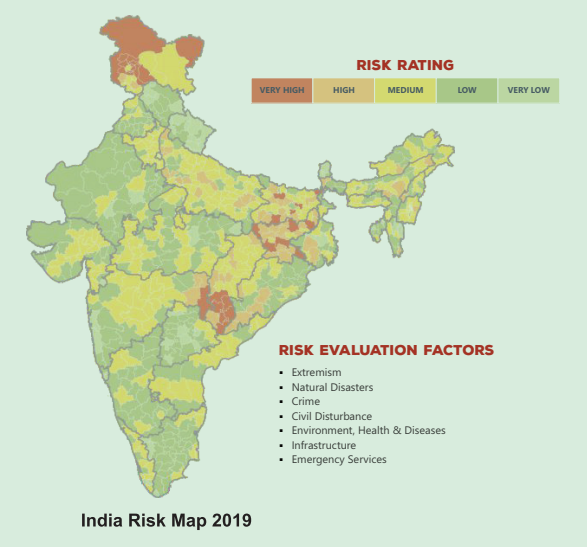
2019 will be critical for security professionals due to the Lok Sabha elections scheduled to be held in the months of April-May. As we move into 2019, security professionals are likely to face dynamic and more evolving security threats worldwide. Terrorism and geopolitical stress, along with other traditional security threats, will remain an area of concern along with non-traditional threats in both the physical and cyber realms.
Overall business climate for 2019
India’s economic growth has progressed in the last two years. This can be attributed to numerous reforms adopted by the government making India the world’s fastest growing economy, accounting for about 15% of the global growth in 2018. With the implementation of the Goods and Services Tax (GST), and with an increasing amount of investments by the Foreign Direct Investment (FDI), the International Monetary Fund (IMF) has predicted a growth rate of over 7.5% post-March 2019. Along with this rise, India was also ranked higher in the Ease of Doing Business (EoDB) ranking, and the third largest start-up base in the world with over 4,750 technology start-ups.
With respect to banking operations in the country, the central government along with the Reserve Bank of India (RBI), has taken major steps to improve the banks’ recognition of bad assets and to recapitalize public sector banks. The Government of India has also decided to invest INR 2.11 trillion (USD 32.9 billion) to recapitalise public sector banks over the next two years.
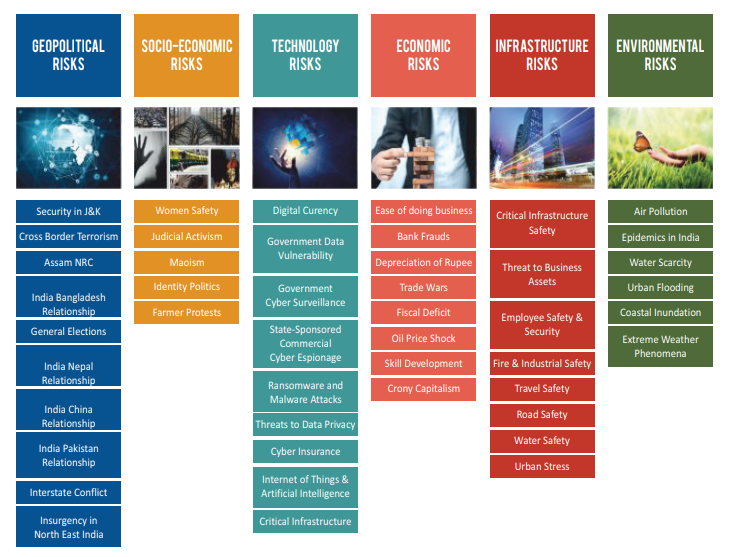
In 2019, two initiatives driven by the Centre namely the ‘Make in India’ and ‘Digital India’ would be playing a pivotal role in India’s economic growth. Under the Make in India initiative, the Indian government is aiming to accelerate the growth rate to 25% of the gross domestic product (GDP) from the current 17%. Under the regulatory framework, all Indian states are on reform and fast growth trajectory, creating favourable conditions for investments and a benign supportive regulatory framework. For achieving these goals, businesses in India are likely to face major hurdles from all the sectors, and India will also have to work strategically to meet the fiscal deficit target for the year.
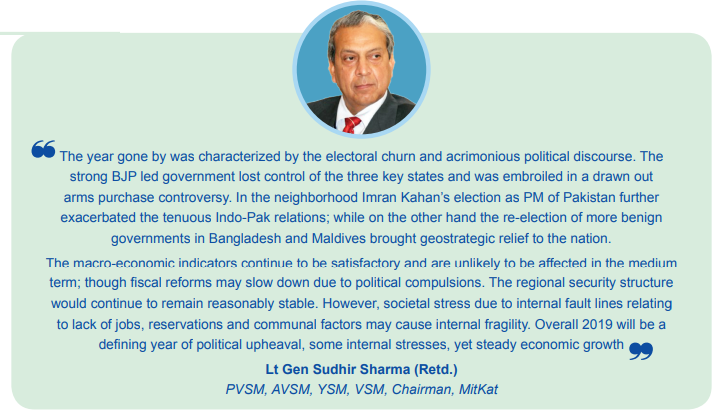
Top business risks
Economic Risks
Strong economic growth in a few countries has created an imbalance for the emerging markets and has put pressure on their currencies. India has been no exception to this trend with the rupee coming under economic stress and the crude oil bill on the rise. The country’s current account deficit is widening and it is expected to continue growing larger over the next few months. Meanwhile, India has made progress in the Ease of Doing Business (EoDB) index and the skill development sector.
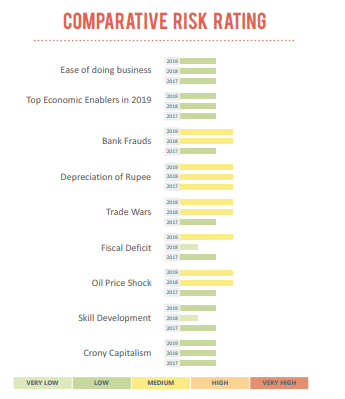
India’s world-beating economic growth is running up against some big risks like high oil prices, emerging market stress as the era of easy money draws to a close, and policy paralysis in the run-up to the 2019 general election. However, the economist intelligence unit forecasts India’s growth to be at 7.4%, throughout 2019. The next government will take charge in a less than ideal economic environment and will have significant challenges to take the economy back into the stable zone, let alone a double-digit growth rate.
The Indian economy is at an interesting stage. In the last few years, structural reforms like GST implementation, demonetisation, insolvency laws, auctioning of public resources, digitisation, expansion of the tax base have created short-term pains in terms of disruptions and high compliance cost. The long-term benefits of these reforms are likely to accrue in 2019 and beyond. The Indian economy looks well-poised for 2019 with low inflation, fairly-valued rupee, under-control fiscal and current account deficits, and transparency in the banking system. Oil price movement will continue to play a crucial role in performance of the Indian economy. The forex reserves of the country at nearly USD400 billion also provides adequate buffer to external sector vulnerabilities.
Environment Risks
I n 2018, India witnessed a series of extreme weather phenomena like floods, dust storms, air pollution, cloudbursts and landslides in several states. The Global Climate Risk Index of 2018 ranks India as the 12th most vulnerable country in the world to climate change impacts.
In 2018, Mumbai, Chennai, Kerala and Delhi-NCR witnessed heavy rainfall and waterlogging, which disrupted business operations. Floods also led to over a thousand fatalities in several states including Uttar Pradesh, Rajasthan, Assam, West Bengal, Kerala and Karnataka. Kerala witnessed one of the worst floods in South Asia in 2018, where over 1.4 million people took shelter in relief camps and there were close to 500 casualties.
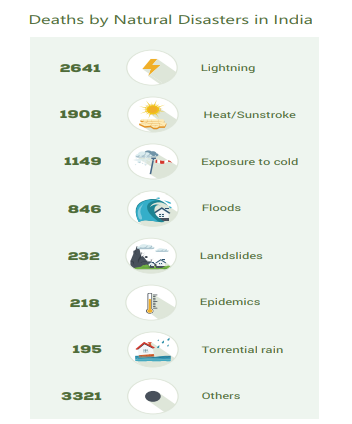
Due to the rise in temperature, dust storms were reported in multiple north Indian states. In 2019, the weather situation is likely to worsen due to global warming and drastically changing climatic conditions.
Although, the United Nations backed fund has approved USD43.4 million for enhancing climate resilience for citizens in coastal states of Andhra Pradesh, Maharashtra and Odisha, India lacks the adequate implementation infrastructure.
Rainfall, floods and dust storms are likely to continue into 2019 with changing weather conditions and fast-paced unchecked urban development, causing severe impacts to the business.
Geopolitcal Risks
Jammu & Kashmir, the north-eastern states and the Maoist belt remain one of the highly volatile regions in the country with frequent reports of unpredictable violence, including bombings, shootings and kidnapping. There have been a number of terrorist attacks against army bases and other targets in Jammu and Kashmir. Even though there has been a considerable decrease in the number of Maoist incidence in the country, a change in Maoist leadership within the organisation could spur the cadres to prove their mettle. The Northeast, in addition to facing its own insurgency issues, is in the process of updating the National Registry of Citizenship in Assam and has caused a ripple in other north eastern states as well. The years-old citizenship issue has riled up smaller communities, political parties and several local organisations, bringing the region to the brink of a possible social conflict. This issue also has a potential to spill over to the year 2019 until a consensus is arrived by the government and all stakeholders.
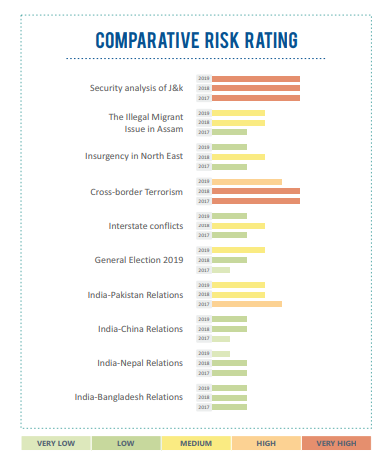
Apart from India’s internal security challenges, the country is also facing a regional hegemonic shift in South Asia with China being increasingly interested in investing in diverse industries and sectors in Nepal, Pakistan, Sri Lanka, Maldives and Bangladesh. Even though these south asian countries are more culturally similar to India, soft power has not been favourable enough to prove India’s interest in these countries. The US-China trade wars may present favourable opportunities to the Indian economy in the south asian region by way of diverted foreign investments, yet regional tariffs may hamper India’s manufacturing industries in the coming months.
Infrastructure Risks
I nfrastructure is a core service upon which other services and business functions operate. As a result, the risks of infrastructure failures are often judged to have a significant potential impact. Insufficient or underdeveloped infrastructure presents one of the biggest obstacles to economic growth and social development worldwide. In India, critical infrastructure safety, employee safety, and travel safety have been the top categories of risk due to poor amenities, ignorance and high costs.
Doing business in India has always been hampered by poor infrastructure and potential failure of critical infrastructure. Lack of dedicated freight corridors, poor warehousing facilities (including cold storage), overburdened railway network, uneven distribution of electricity and lack of implementation of industry safety standards have always affected investor sentiment and business operations in India.
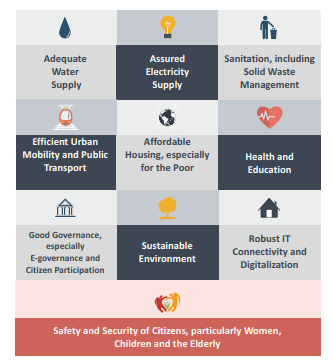
Over the past few years, there has been a massive thrust by the Government to increase spending on infrastructure, not only on roads, but other verticals like railways, metros, housing, airports, water etc. The budget expenditure on these have moved up from USD13 billion in 2016 to USD26 billion in 2018-19 indicating a quantum jump. Given the upcoming elections, there has been a certain slowdown in ordering activities. However, the outlook is promising with potential approval of large projects like the Delhi-Mumbai Industrial Corridor (DMIC), river interlinking and expansion of regional airport infrastructure.
Socio-Economic Risks
Throughout 2018, various public protests disrupted business continuity in India including the following:
- Several strikes and protests were initiated by minority groups, farmers, labour unions, student union etc. Farmers regularly protested over several demands including loan waiver in multiple states of India.
- Multiple protests over the draft of the National Register of Citizens (NRC) were reported in Assam, New Delhi and in parts of West Bengal.
- In the month of April, 10 people were killed in a nationwide shutdown organised by minority groups. In an environmental protest in Thoothukudi, Tamil Nadu, 13 people were killed and over 100 were injured.
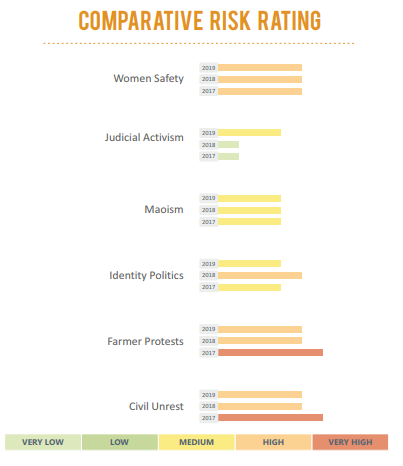
- In Delhi, traders under the umbrella of Confederation of All India Traders (CAIT) protested the sealing of shops. App-based taxi drivers and truckers’ association calledfor strikes in several parts of the country. The pan-India eight-day strike in the month of July resulted in a revenue loss of about USD556 million per day.
- As general elections are planned in May 2019, public protests and political rallies are likely to increase across India. Protest by farmers and minority groups over reservations policies in several states are also likely to escalate. Further, political rallies before elections are likely to impact business operations.
Technological Risks
In 2015, the GOI introduced the Digital India program, bringing to focus an approach that resulted in over 500 million internet users in the country. This has led to major cybersecurity issues in the country. In 2018, India was the 4th most cyber attacked country in the world. According to the Ministry of Electronics and Information Technology, the maximum number of cyber-attacks were carried out by China (35%), US (17%), Russia (15%) and Pakistan (09%) in just three months (April-June 2018).
In 2018, 15,779 Indian websites were hacked. India’s Cosmos Bank lost nearly INR944 million through simultaneous withdrawals across 28 countries after the bank’s systems were hacked. In 2019, the situation is further likely to deteriorate with the increase in internet accessibility and with the rise in vulnerable cyber blind-spots in businesses. With general elections planned in India in 2019, data breach and other cyber-attacks might be used to influence election results.
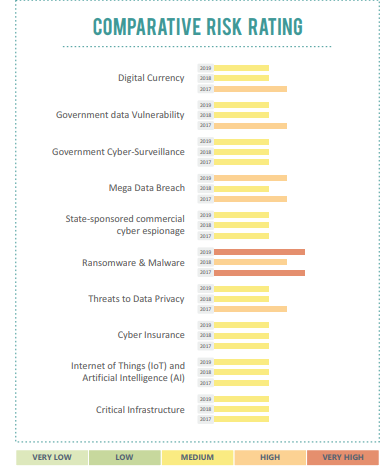
What to expect in 2019
2018 for India has been a tumultuous year with a declining rupee value, political campaigns for state elections, acute pressure on resources due to the occurrence of natural hazards, rising tension in the border, and protests by several traders, political parties and farmers’ unions. The economy grew by 8.2% year-on-year in the first quarter of fiscal year 2018/19 (April-March), driven by an upswing in household demand. In the coming quarters, rising interest rates, currency volatility and higher inflation adversely affecting consumer purchasing power will weigh on growth. The pace of the real GDP is likely to decelerate slightly in the remainder of 2018-19. Meanwhile, campaigning by political parties will intensify ahead of the general elections.
- Civil disturbances and protests are likely to continue unabated in 2019 due to political rallies, campaigns, security threats, protests and poll violence. Political violence over the issues of Ram temple, reservations for minority groups, and farmers loan waiver promises.
- Separatist violence in Jammu & Kashmir is also likely to increase due to high militant recruitments and rising border tension. The security forces are likely to retain control over the insurgency in northeast India and Maoist affected areas in central and western India.
- The gross domestic product (GDP) growth rate is forecast to remain over 7.5%, however, the improvement in the currency value is likely to slow down due to the strengthening of the US dollar (USD). The ease of doing business in India is likely to improve in 2019 due to several business friendly policies that have been implemented in 2017 and 2018.
- Climate change in 2019 is a major concern for the country with very heavy rainfall in the monsoon and extremely high temperatures during summers causing loss of workdays and hampering business continuity. Due to the climate change in the Indian Ocean and Bay of Bengal, severe cyclones, floods and landslides are likely along India’s coastline. Dust storms and air pollution also would be of major concern for the citizens of northern India.
Overall, the outlook for businesses in India for 2019 with respect to civil risks would depend on the outcome of the upcoming general elections. Businesses are likely to face day-to-day challenges of civil disturbances and the manifestations of climate change which are expected to escalate in 2019.
